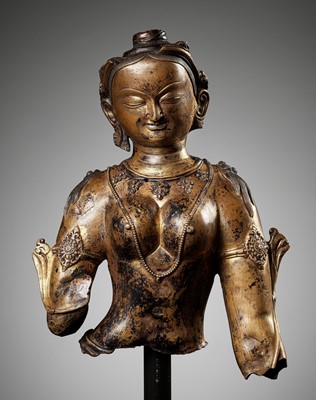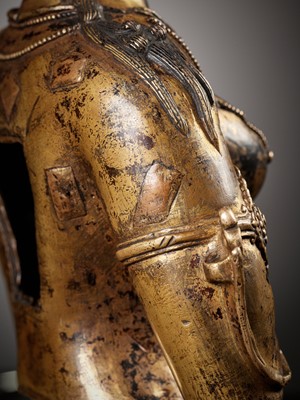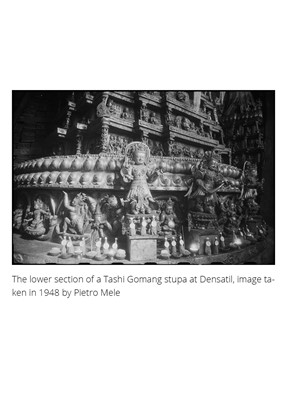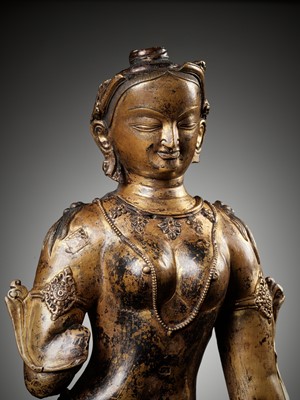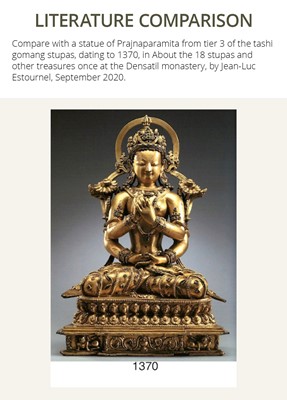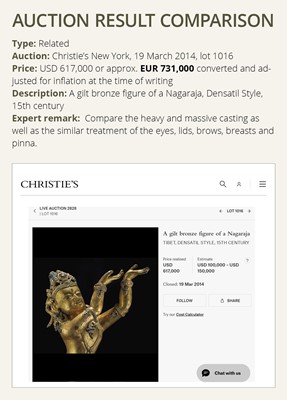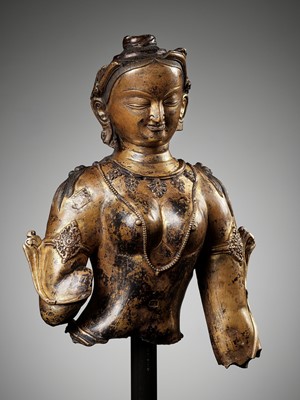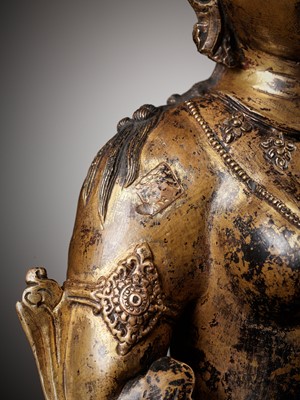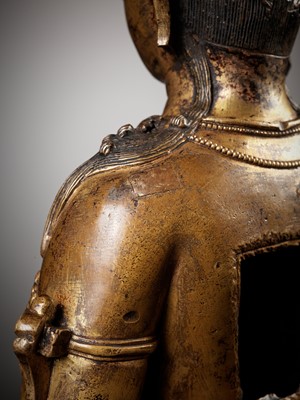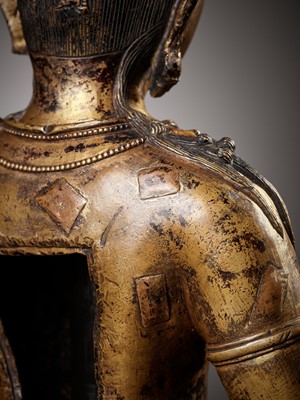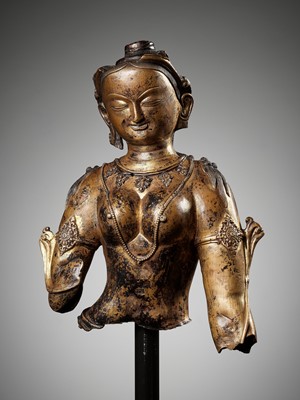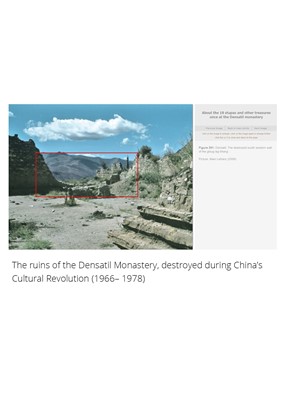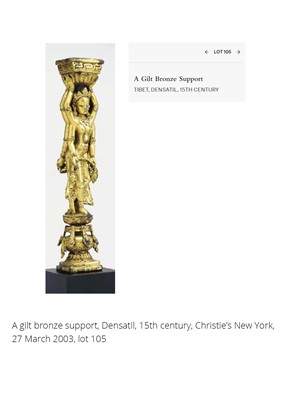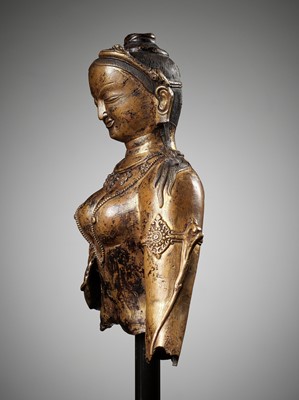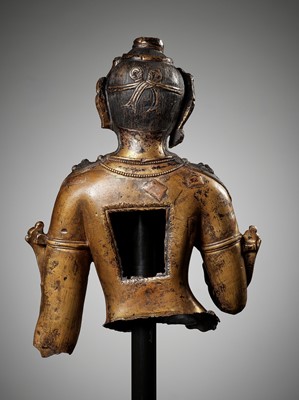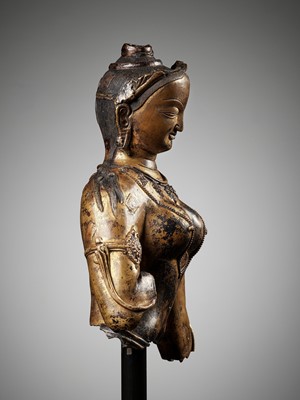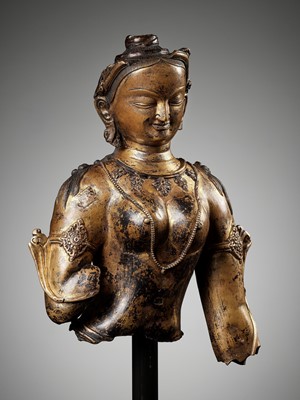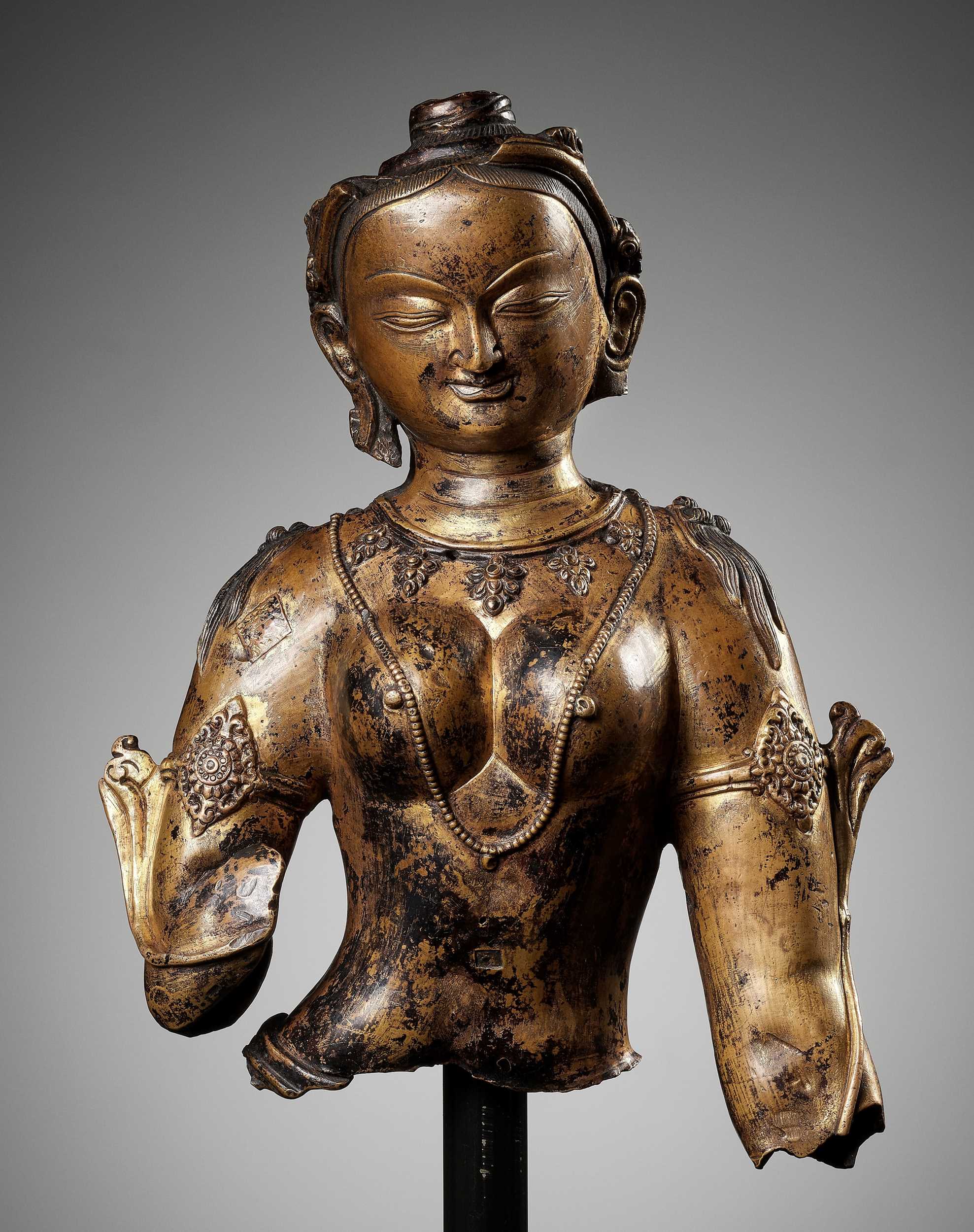29th Sep, 2022 13:00
DAY 1 - TWO-DAY AUCTION - Fine Chinese Art / 中國藝術集珍 / Buddhism & Hinduism
167
A LARGE FRAGMENTARY BUST OF A FEMALE DEITY, GILT COPPER-ALLOY, PROBABLY DENSATIL, TIBET, 14TH-15TH CENTURY
十四至十五世紀西藏大型銅鎏金女神半身像
Sold for €19,500
including Buyer's Premium
Opinion: The particularly well-proportioned female image, possibly Prjanaparamita, with its simple yet sensuous appearance is – at first glance – evocative of high Newari craftsmanship, popularly commissioned by wealthy Tibetan monastic patrons during the 14th and 15th centuries. However, after looking at some of the characteristics more closely, several distinct features make an attribution to the Densatil monastery seem more appropriate. Chief among the diagnostic traits that can identify a work from the Densatil are the convexly stepped eyebrows and the precisely incised double-lined eyelids and lips. The oval pinna, remotely signifying a lotus-petal, from which the lavish hairbands issue seamlessly, is another unequivocal feature, as are the extra-thick and heavy casting overall and the leaning head, which indicates that the present lot may once have been part of a larger supporting structure. For example compare a gilt bronze support, Densatil, 15th century, at Christie’s New York, 27 March 2003, lot 105.
Finally, the harrowing brutality to which this image was evidently exposed is a silent monument to the destruction of Densatil during China’s Cultural Revolution (1966-1978), where one of the most inspiring cultural heritages of mankind became victim to an unconscionable mob.
Superbly cast, richly adorned with a beaded and a floral necklace above her voluptuous breasts as well as lotiform armlets, the face with a serene expression, the eyes with distinct sinuous lids and raised brows, both heightened with subtle incision work, as well as full lips forming a calm smile, the neatly incised hair parted in the middle and secured by a tiara.
Provenance: From a private collection in Paris, France.
Condition: Condition overall as expected and commensurate with age. Extensive wear and losses. Dents, nicks, scratches and battering. Wear to gilt. All semi-precious stone inlays are now lost. Several distinct ritual patches.
Weight: 3,472 g
Dimensions: Height 33 cm
Heavily cast gilt copper-alloy figures of this type are characteristic of the Densatil style, a Kagyu monastic complex in central Tibet, southeast of Lhasa, that has long been considered one of the great treasures of Tibet. Founded in the late 12th century, it enjoyed generous patronage and was lavishly decorated during a period of expansion from circa 1360 until the early 16th century. The monastery was known for eight extraordinary memorial stupas symbolizing Buddha's first teaching in Benares. These stupas were called tashi gomang, meaning "many doors of auspiciousness," and were multi-tiered copper-alloy structures filled with deities such as the present example, standing more than ten feet tall and resplendent with inlays of semiprecious stones. Prior to the destruction of Densatil during China’s Cultural Revolution (1966-1978), eight of them dating between 1208 and 1432 stood in the Monastery’s main hall.
Followers of the charismatic Phagmo Drupa Dorje Gyalpo (1110–1170) constructed the Densatil Monastery. His school, which came to be known as Phagmo Drupa Kagyu, was one of the four primary schools of the Kagyu lineage of Tibetan Buddhism. Its noble house became so powerful that their dynasty ruled from the mid-fourteenth to the mid-fifteenth century. Eventually it had died out by the end of the seventeenth century, but the Densatil Monastery survived intact under the control of other Tibetan Buddhist schools until it was eventually destroyed. Today the monastery is undergoing reconstruction thanks to the efforts of the Tibetan Autonomous Region Ministry of Culture and the Drigung (Drikung) Kagyu school.
Literature comparison: Compare with a statue of Prajnaparamita from tier 3 of the tashi gomang stupas, dating to 1370, in About the 18 stupas and other treasures once at the Densatil monastery, by Jean-Luc Estournel, September 2020.
Auction result comparison:
Type: Related
Auction: Christie’s New York, 19 March 2014, lot 1016
Price: USD 617,000 or approx. EUR 731,000 converted and adjusted for inflation at the time of writing
Description: A gilt bronze figure of a Nagaraja, Densatil Style, 15th century
Expert remark: Compare the heavy and massive casting as well as the similar treatment of the eyes, lids, brows, breasts and pinna.
十四至十五世紀西藏大型銅鎏金女神半身像
鑄工精湛,女神豐胸纖腰,體態婀娜,胸前飾有瓔珞和花卉,手臂上有團蓮紋臂環;面容安詳,眼睛彎曲,眉毛上揚,飽滿嘴唇,先露出一抹慈祥平靜的笑容;頭髮從中間分開,用頭飾固定。
專家注釋:特別勻稱的女性形象,可能是般若菩薩,其簡單而感性的外觀 - 乍一看 - 令人回想起十四世紀和十五世紀西藏寺院富有的贊助人經常委託的紐瓦里工藝。然而,在更仔細地研究了一些特徵之後,幾個不同的地方,讓人更能確定,這座半身像可能來自丹薩替寺,比如她凸出的階梯式眉毛和清晰的雙眼皮和嘴唇。橢圓形耳廓,蓮花髮帶,是另一個明確的特徵。整體厚重,包括傾斜的頭部,這表明本拍品可能有更大的支撐結構。例如,比較一個鎏金青銅支架。丹薩蒂爾寺,15世紀,紐約佳士得,2003年3月27日,編號105。
丹薩替寺在中國文化大革命(1966-1978)期間被毀,實在令人痛心。
來源:法國巴黎私人收藏。
品相:整體狀況符合預期,大面積磨損和缺損。凹痕、刻痕、劃痕,鎏金磨損。很多寶石遺失,幾個修補。幾個儀式留下來的明顯斑塊。
重量:3,472克
尺寸:高33厘米
此類型的重鑄鎏金銅合金造像是丹薩蒂爾寺風格的特徵,它是位於中國西藏自治區山南地區桑日縣的一座藏傳佛教帕竹噶舉派寺院,是帕竹噶舉派的第一座寺院。丹薩蒂爾寺的各類佛教造像數量很多,十分珍貴。它始建於十二世紀末,獲得了慷慨的讚助,並在大約1360年至十六世紀初的擴建。該寺院以八座非凡的佛塔而聞名,這些佛塔象徵著佛陀在貝拿勒斯的第一次教導。這些佛塔被稱為扎西五芒,意思是“許多吉祥之門”,是多層銅合金結構,裡面裝滿了如此拍品一般的造像,高十多英尺,鑲嵌著寶石,金碧輝煌。在中國文化大革命(1966-1978年)期間,丹薩蒂爾寺被毀之前,有8座1208年至1432年的作品矗立在寺院的大殿裡。
文獻比較:比較一件扎西五芒的三層1370年普賢菩薩像,Jean-Luc Estournel 〈About the 18 stupas and other treasures once at the Densatil monastery〉,2020年9月。
拍賣結果比較:
形制:相近
拍賣:紐約佳士得,2014年3月19日,lot 1016
價格:USD 617,000(相當於今日EUR 731,000)
描述:十五世紀丹薩蒂爾寺風格銅鎏金那伽像
專家評論:比較重鑄技術,以及相似的眼睛、眼瞼、眉毛、胸型和耳廓。
Opinion: The particularly well-proportioned female image, possibly Prjanaparamita, with its simple yet sensuous appearance is – at first glance – evocative of high Newari craftsmanship, popularly commissioned by wealthy Tibetan monastic patrons during the 14th and 15th centuries. However, after looking at some of the characteristics more closely, several distinct features make an attribution to the Densatil monastery seem more appropriate. Chief among the diagnostic traits that can identify a work from the Densatil are the convexly stepped eyebrows and the precisely incised double-lined eyelids and lips. The oval pinna, remotely signifying a lotus-petal, from which the lavish hairbands issue seamlessly, is another unequivocal feature, as are the extra-thick and heavy casting overall and the leaning head, which indicates that the present lot may once have been part of a larger supporting structure. For example compare a gilt bronze support, Densatil, 15th century, at Christie’s New York, 27 March 2003, lot 105.
Finally, the harrowing brutality to which this image was evidently exposed is a silent monument to the destruction of Densatil during China’s Cultural Revolution (1966-1978), where one of the most inspiring cultural heritages of mankind became victim to an unconscionable mob.
Superbly cast, richly adorned with a beaded and a floral necklace above her voluptuous breasts as well as lotiform armlets, the face with a serene expression, the eyes with distinct sinuous lids and raised brows, both heightened with subtle incision work, as well as full lips forming a calm smile, the neatly incised hair parted in the middle and secured by a tiara.
Provenance: From a private collection in Paris, France.
Condition: Condition overall as expected and commensurate with age. Extensive wear and losses. Dents, nicks, scratches and battering. Wear to gilt. All semi-precious stone inlays are now lost. Several distinct ritual patches.
Weight: 3,472 g
Dimensions: Height 33 cm
Heavily cast gilt copper-alloy figures of this type are characteristic of the Densatil style, a Kagyu monastic complex in central Tibet, southeast of Lhasa, that has long been considered one of the great treasures of Tibet. Founded in the late 12th century, it enjoyed generous patronage and was lavishly decorated during a period of expansion from circa 1360 until the early 16th century. The monastery was known for eight extraordinary memorial stupas symbolizing Buddha's first teaching in Benares. These stupas were called tashi gomang, meaning "many doors of auspiciousness," and were multi-tiered copper-alloy structures filled with deities such as the present example, standing more than ten feet tall and resplendent with inlays of semiprecious stones. Prior to the destruction of Densatil during China’s Cultural Revolution (1966-1978), eight of them dating between 1208 and 1432 stood in the Monastery’s main hall.
Followers of the charismatic Phagmo Drupa Dorje Gyalpo (1110–1170) constructed the Densatil Monastery. His school, which came to be known as Phagmo Drupa Kagyu, was one of the four primary schools of the Kagyu lineage of Tibetan Buddhism. Its noble house became so powerful that their dynasty ruled from the mid-fourteenth to the mid-fifteenth century. Eventually it had died out by the end of the seventeenth century, but the Densatil Monastery survived intact under the control of other Tibetan Buddhist schools until it was eventually destroyed. Today the monastery is undergoing reconstruction thanks to the efforts of the Tibetan Autonomous Region Ministry of Culture and the Drigung (Drikung) Kagyu school.
Literature comparison: Compare with a statue of Prajnaparamita from tier 3 of the tashi gomang stupas, dating to 1370, in About the 18 stupas and other treasures once at the Densatil monastery, by Jean-Luc Estournel, September 2020.
Auction result comparison:
Type: Related
Auction: Christie’s New York, 19 March 2014, lot 1016
Price: USD 617,000 or approx. EUR 731,000 converted and adjusted for inflation at the time of writing
Description: A gilt bronze figure of a Nagaraja, Densatil Style, 15th century
Expert remark: Compare the heavy and massive casting as well as the similar treatment of the eyes, lids, brows, breasts and pinna.
十四至十五世紀西藏大型銅鎏金女神半身像
鑄工精湛,女神豐胸纖腰,體態婀娜,胸前飾有瓔珞和花卉,手臂上有團蓮紋臂環;面容安詳,眼睛彎曲,眉毛上揚,飽滿嘴唇,先露出一抹慈祥平靜的笑容;頭髮從中間分開,用頭飾固定。
專家注釋:特別勻稱的女性形象,可能是般若菩薩,其簡單而感性的外觀 - 乍一看 - 令人回想起十四世紀和十五世紀西藏寺院富有的贊助人經常委託的紐瓦里工藝。然而,在更仔細地研究了一些特徵之後,幾個不同的地方,讓人更能確定,這座半身像可能來自丹薩替寺,比如她凸出的階梯式眉毛和清晰的雙眼皮和嘴唇。橢圓形耳廓,蓮花髮帶,是另一個明確的特徵。整體厚重,包括傾斜的頭部,這表明本拍品可能有更大的支撐結構。例如,比較一個鎏金青銅支架。丹薩蒂爾寺,15世紀,紐約佳士得,2003年3月27日,編號105。
丹薩替寺在中國文化大革命(1966-1978)期間被毀,實在令人痛心。
來源:法國巴黎私人收藏。
品相:整體狀況符合預期,大面積磨損和缺損。凹痕、刻痕、劃痕,鎏金磨損。很多寶石遺失,幾個修補。幾個儀式留下來的明顯斑塊。
重量:3,472克
尺寸:高33厘米
此類型的重鑄鎏金銅合金造像是丹薩蒂爾寺風格的特徵,它是位於中國西藏自治區山南地區桑日縣的一座藏傳佛教帕竹噶舉派寺院,是帕竹噶舉派的第一座寺院。丹薩蒂爾寺的各類佛教造像數量很多,十分珍貴。它始建於十二世紀末,獲得了慷慨的讚助,並在大約1360年至十六世紀初的擴建。該寺院以八座非凡的佛塔而聞名,這些佛塔象徵著佛陀在貝拿勒斯的第一次教導。這些佛塔被稱為扎西五芒,意思是“許多吉祥之門”,是多層銅合金結構,裡面裝滿了如此拍品一般的造像,高十多英尺,鑲嵌著寶石,金碧輝煌。在中國文化大革命(1966-1978年)期間,丹薩蒂爾寺被毀之前,有8座1208年至1432年的作品矗立在寺院的大殿裡。
文獻比較:比較一件扎西五芒的三層1370年普賢菩薩像,Jean-Luc Estournel 〈About the 18 stupas and other treasures once at the Densatil monastery〉,2020年9月。
拍賣結果比較:
形制:相近
拍賣:紐約佳士得,2014年3月19日,lot 1016
價格:USD 617,000(相當於今日EUR 731,000)
描述:十五世紀丹薩蒂爾寺風格銅鎏金那伽像
專家評論:比較重鑄技術,以及相似的眼睛、眼瞼、眉毛、胸型和耳廓。
Zacke Live Online Bidding
Our online bidding platform makes it easier than ever to bid in our auctions! When you bid through our website, you can take advantage of our premium buyer's terms without incurring any additional online bidding surcharges.
To bid live online, you'll need to create an online account. Once your account is created and your identity is verified, you can register to bid in an auction up to 12 hours before the auction begins.
Intended Spend and Bid Limits
When you register to bid in an online auction, you will need to share your intended maximum spending budget for the auction. We will then review your intended spend and set a bid limit for you. Once you have pre-registered for a live online auction, you can see your intended spend and bid limit by going to 'Account Settings' and clicking on 'Live Bidding Registrations'.
Your bid limit will be the maximum amount you can bid during the auction. Your bid limit is for the hammer price and is not affected by the buyer’s premium and VAT. For example, if you have a bid limit of €1,000 and place two winning bids for €300 and €200, then you will only be able to bid €500 for the rest of the auction. If you try to place a bid that is higher than €500, you will not be able to do so.
Online Absentee and Telephone Bids
You can now leave absentee and telephone bids on our website!
Absentee Bidding
Once you've created an account and your identity is verified, you can leave your absentee bid directly on the lot page. We will contact you when your bids have been confirmed.
Telephone Bidding
Once you've created an account and your identity is verified, you can leave telephone bids online. We will contact you when your bids have been confirmed.
Classic Absentee and Telephone Bidding Form
You can still submit absentee and telephone bids by email or fax if you prefer. Simply fill out the Absentee Bidding/Telephone bidding form and return it to us by email at office@zacke.at or by fax at +43 (1) 532 04 52 20. You can download the PDF from our Upcoming Auctions page.
How-To Guides
How to Create Your Personal Zacke Account
How to Register to Bid on Zacke Live
How to Leave Absentee Bids Online
How to Leave Telephone Bids Online
中文版本的操作指南
创建新账号
注册Zacke Live在线直播竞拍(免平台费)
缺席投标和电话投标
Third-Party Bidding
We partner with best-in-class third-party partners to make it easy for you to bid online in the channel of your choice. Please note that if you bid with one of our third-party online partners, then there will be a live bidding surcharge on top of your final purchase price. You can find all of our fees here. Here's a full list of our third-party partners:
- 51 Bid Live
- EpaiLive
- ArtFoxLive
- Invaluable
- LiveAuctioneers
- the-saleroom
- lot-tissimo
- Drouot
Please note that we place different auctions on different platforms. For example, in general, we only place Chinese art auctions on 51 Bid Live.
Bidding in Person
You must register to bid in person and will be assigned a paddle at the auction. Please contact us at office@zacke.at or +43 (1) 532 04 52 for the latest local health and safety guidelines.

